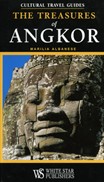 I've just received a gorgeous new traveller's guidebook called The Treasures of Angkor by Italian journalist Marilia Albanese. Its published by White Star and is a great addition to the guides that currently exist to help tourists decipher the crown jewels of Cambodia, the Angkor temple complex. Albanese is a scholar of Indian art and has written a number of books about India before turning her attention to Cambodia. In 2003 she published Angkor: Splendors of the Khmer Civilization, a 300 page coffee table-sized book that provided an in-depth commentary on the history and beliefs of the Khmers, alongwith a host of beautiful photos.
I've just received a gorgeous new traveller's guidebook called The Treasures of Angkor by Italian journalist Marilia Albanese. Its published by White Star and is a great addition to the guides that currently exist to help tourists decipher the crown jewels of Cambodia, the Angkor temple complex. Albanese is a scholar of Indian art and has written a number of books about India before turning her attention to Cambodia. In 2003 she published Angkor: Splendors of the Khmer Civilization, a 300 page coffee table-sized book that provided an in-depth commentary on the history and beliefs of the Khmers, alongwith a host of beautiful photos.
For her latest publication, Albanese has compiled a compact and handy pocket-sized guide that houses a wealth of information within its 290 pages on each temple in the Angkor complex, together with a temple plan and what to look out for on your visit. The photos in the guidebook are excellent, especially the close-up pictures of some of the statues to be found in the National Museum and in the Guimet Museum in Paris. The author also takes you on a trip through the various stages of the developing artistic styles and the basic elements of the temple structures as well as identifying the carvings and deities you'll encounter along the way. The temples themselves are explored in six groupings, mostly in chronological order though with some variations. I'm sure the guide will prove popular because of its size and depth of information. It reminded me of a more slimline and convenient to carry version of the excellent Ancient Angkor by Michael Freeman and Claude Jacques.
Thursday, August 31, 2006
Albanese's Angkor
Wednesday, August 30, 2006
Camerado on film
 Filmmaker Jason Rosette, aka Camerado, has now been in Cambodia for a year and a half and he's already made two documentaries about Cambodian issues, namely Crisis, which is about land alienation(land-grabbing) in indigenous areas such as Ratanakiri, and his most recent work, Have Forest, Have Life, a co-production for WildAid, Conservation International and FFI. Both of these are viewable on google video and can be accessed from his website here. Whilst living in Phnom Penh, he's also edited his second feature film, a social fiction feature called Susan Hero, which was shot on location in the US and New Mexico. His first feature was the highly-acclaimed and gritty Bookwars: Life on the Streets of New York.
Filmmaker Jason Rosette, aka Camerado, has now been in Cambodia for a year and a half and he's already made two documentaries about Cambodian issues, namely Crisis, which is about land alienation(land-grabbing) in indigenous areas such as Ratanakiri, and his most recent work, Have Forest, Have Life, a co-production for WildAid, Conservation International and FFI. Both of these are viewable on google video and can be accessed from his website here. Whilst living in Phnom Penh, he's also edited his second feature film, a social fiction feature called Susan Hero, which was shot on location in the US and New Mexico. His first feature was the highly-acclaimed and gritty Bookwars: Life on the Streets of New York.
For his third feature, Camerado (pictured) is focusing on Cambodia and is currently developing a film titled Snack, Breakfast, Dinner, which will contain interconnecting stories on the ground and in the air during America's secret bombing of Cambodia, known as Operation Menu. He's keen for this feature to be as locally produced as possible, with Khmer talent in front and behind the camera. One stumbling block has been getting hold of a fuselage section of a B-52 which can be used as a mockup for the interior bombing scenes. Has anyone got one in their backyard? He's also been busy shooting and making lots of shorts and smaller stuff: one about the boat races, also working on one about the resurgence of kites. Keep your eyes peeled for more of Camerado's work.
Monday, August 28, 2006
Culture and RasItes top the bill
 I'm just out the door to watch a Bank Holiday football match, so this will be quick. Got in at 3am this morning after a trip to Shrewsbury's Buttermarket venue to watch the reggae band Culture perform, just eight days after they lost their legendary lead vocalist Joseph Hill. After 30 years in the reggae music business, Hill passed away suddenly during the band's current European tour and his son, Kenyatta, usually the band's sound engineer, has taken over lead vocals, supported by Albert Walker and Telford Nelson, and their backing band, the Forces of Justice. The boy did his father proud and the Buttermarket punters were treated to a great show. Also on the bill were the talented UK reggae band The RasItes (pictured), who played a free gig in the Town Centre a few hours earlier. The four friends from north London have been together for ten years even though they're still in their early twenties, and are looking to release their second album soon. The four are Jahmel Ellison (bass and vox), Kashta Menelick Tafari (lead and vox), Cyrus Richards (keys) and Otis Cox-Rodney (drums). I chatted to Jahmel before the gig and he explained that the band are probably better known in Europe, where they perform regularly at the major festivals, than they are in their own backyard though he hopes their next album will change that.
I'm just out the door to watch a Bank Holiday football match, so this will be quick. Got in at 3am this morning after a trip to Shrewsbury's Buttermarket venue to watch the reggae band Culture perform, just eight days after they lost their legendary lead vocalist Joseph Hill. After 30 years in the reggae music business, Hill passed away suddenly during the band's current European tour and his son, Kenyatta, usually the band's sound engineer, has taken over lead vocals, supported by Albert Walker and Telford Nelson, and their backing band, the Forces of Justice. The boy did his father proud and the Buttermarket punters were treated to a great show. Also on the bill were the talented UK reggae band The RasItes (pictured), who played a free gig in the Town Centre a few hours earlier. The four friends from north London have been together for ten years even though they're still in their early twenties, and are looking to release their second album soon. The four are Jahmel Ellison (bass and vox), Kashta Menelick Tafari (lead and vox), Cyrus Richards (keys) and Otis Cox-Rodney (drums). I chatted to Jahmel before the gig and he explained that the band are probably better known in Europe, where they perform regularly at the major festivals, than they are in their own backyard though he hopes their next album will change that.
Sunday, August 27, 2006
Bookends
I've been a busy bee, with three books on the go at once including reading a friend's excellent manuscript for an historical novel which I hope will come out sometime next year. More nearer the time. One of the books I've just finished is John Tully's A Short History of Cambodia: From Empire to Survival, and I really enjoyed it. The author's style was engaging and easy to follow, not heavy at all and its intended audience - tourists, students and general readers with an interest in SEAsia - will gain much from his concise interpretation of Cambodia's chequered history, which is awash with war, invasion and conflict. Throughout, you can't but feel for the Khmer people who've borne the brunt of so much for so long.
The book, published by Allen & Unwin, is 270 pages long. Its not as detailed as David Chandler's History of Cambodia but its not intended to be and hits the spot perfectly in my view. Interestingly, Dr Tully is a lecturer at the Victoria University in Melbourne and pays his dues to his former tutor, David Chandler, acknowledged as the great Cambodian historian. In my opinion, he does a fine job following in his mentor's footsteps. You can get the book here.
Saturday, August 26, 2006
Bombhunters in Cambodia
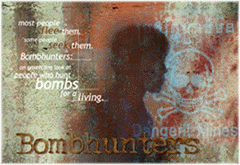 Independent film producer Skye Fitzgerald's film, Bombhunters, explores the long-term consequences of war and genocide in Cambodia that persist in the form of landmines, unexploded ordnance (UXO), and other munitions. In particular, his film examines the social, cultural, and historical context and experiences of rural villagers who risk their lives to seek out and dismantle UXO to sell the scrap metal for profit.
Independent film producer Skye Fitzgerald's film, Bombhunters, explores the long-term consequences of war and genocide in Cambodia that persist in the form of landmines, unexploded ordnance (UXO), and other munitions. In particular, his film examines the social, cultural, and historical context and experiences of rural villagers who risk their lives to seek out and dismantle UXO to sell the scrap metal for profit.
Fitzgerald did much of his filming in Kompong Thom province and includes in his 85-minute film people like Khmer activist Ronnie Yimsut alongwith Aki Ra, a popular former soldier who lives in Siem Reap and has his own landmine museum; Yun Te, whose wife nearly bursts from anxiety, worrying aloud how their two baby girls can survive if her husband loses his arms, his legs, or his life; Salot Vuthee, whose husband lost all of those one unlucky afternoon; and Pon Lok, a handless 13-year-old whose face, neck, and chest are pocked with open and angry shrapnel wounds. Ronnie Yimsut summed up the film thus: "Skye and his film crew, in my eyes at least, are champions for those little people who lack voice. It took courage, but more importantly, it took a strong passion to make this kind of film to educate the public."
Bombhunters is currently showing at film festivals across the United States and earning rave reviews, whilst Fitzgerald is hopeful it will receive wider global distribution. Read more about the film, here.
Thursday, August 24, 2006
The Redlight Children Campaign
 The people that put together the K11 Project - they've produced 3 films focusing on child trafficking and prostitution in SEAsia and particularly Cambodia - have also initiated The Redlight Children Campaign. The intention is to generate conscious concern and inspire immediate action against child sexploitation. It's a worldwide grassroots initiative whose mission is to reduce the number of children sold to the sex industry and exploited on the internet. You can find out more by clicking here. As for the K11 Project, the 60th Edinburgh International Film Festival last week was the stage for the world premier of the film Holly (pictured), and it earned rave reviews as a result. Certainly the K11 Project team are hell-bent on telling their story and getting their message to the masses. Read more here.
The people that put together the K11 Project - they've produced 3 films focusing on child trafficking and prostitution in SEAsia and particularly Cambodia - have also initiated The Redlight Children Campaign. The intention is to generate conscious concern and inspire immediate action against child sexploitation. It's a worldwide grassroots initiative whose mission is to reduce the number of children sold to the sex industry and exploited on the internet. You can find out more by clicking here. As for the K11 Project, the 60th Edinburgh International Film Festival last week was the stage for the world premier of the film Holly (pictured), and it earned rave reviews as a result. Certainly the K11 Project team are hell-bent on telling their story and getting their message to the masses. Read more here.
Tuesday, August 22, 2006
Chris Moon in Kidnapped
 In 1993 ex-soldier and landmine specialist Chris Moon was working with HALO Trust in Cambodia and was kidnapped by the Khmer Rouge whilst de-mining in a remote area. The story of his kidnap, survival and eventual release is told in a new Channel 4 documentary, Kidnapped in the Killing Fields, which will be shown on British television on 10 September 2006 at 8pm as part of the Alive series. Actors will re-enact the scenes (pictured above), which bear a remarkable similarity to the abduction of de-miner Christopher Howes just three years later. Unfortunately for Howes, the result was not the same.
In 1993 ex-soldier and landmine specialist Chris Moon was working with HALO Trust in Cambodia and was kidnapped by the Khmer Rouge whilst de-mining in a remote area. The story of his kidnap, survival and eventual release is told in a new Channel 4 documentary, Kidnapped in the Killing Fields, which will be shown on British television on 10 September 2006 at 8pm as part of the Alive series. Actors will re-enact the scenes (pictured above), which bear a remarkable similarity to the abduction of de-miner Christopher Howes just three years later. Unfortunately for Howes, the result was not the same.
In the case of Chris Moon, he went onto work with HALO in Mozambique, but while on duty he was blown up by a mine and lost his lower right leg and right arm. Since that time, Moon has inspired many with his incredible determination to overcome his disability - he completed the London Marathon less than a year after leaving hospital - and has worked tirelessly for the British charity, The Cambodia Trust. In fact, Moon is taking part in a sponsored bike ride beginning on 31 August when he will cycle across Cambodia on a specially adapted bicycle to raise funds for the charity. You can find out more here.
The Cambodia Trust is a charity that I've personally supported in the past and who've done amazing work in Cambodia and beyond. Meanwhile, to find out more about Chris Moon, go to his own website at www.chrismoon.co.uk.
Monday, August 21, 2006
Tuol Sleng Survivors
 The above photo is reproduced courtesy of DC-Cam and shows a group of survivors from the 20,000 prisoners that were incarcerated in the Tuol Sleng interrogation centre in Phnom Penh between 1975 and 1979. DC-Cam investigations suggest up to fourteen prisoners managed to survive the extermination at the centre though at the time this photo was taken in 1979, only seven had been identified. They were: [RtoL] Chum Mey, Ruy Neakong*, Im Chan*, Vann Nath, Bou Meng, Phan Than Chan* and Ung Pech*. Only three of those pictured survive today - Chum Mey, Vann Nath and Bou Meng.
The above photo is reproduced courtesy of DC-Cam and shows a group of survivors from the 20,000 prisoners that were incarcerated in the Tuol Sleng interrogation centre in Phnom Penh between 1975 and 1979. DC-Cam investigations suggest up to fourteen prisoners managed to survive the extermination at the centre though at the time this photo was taken in 1979, only seven had been identified. They were: [RtoL] Chum Mey, Ruy Neakong*, Im Chan*, Vann Nath, Bou Meng, Phan Than Chan* and Ung Pech*. Only three of those pictured survive today - Chum Mey, Vann Nath and Bou Meng.
I've just watched all of John Pilger's documentaries on Cambodia and one of the original survivors, Ung Pech, was interviewed by Pilger for his first programme, Year Zero. Pech, whose life was spared because of his skill as a mechanic, became the first Director of Tuol Sleng when it opened to the public as a Genocide Museum on 7 January 1980, a year after its liberation. In the interview he described how he lost his wife and five children to starvation and how he himself was tortured. Ung Pech remained as Director until the early '90s and passed away in late 1996.
Saturday, August 19, 2006
Cyclo Centre's Mekong Bike Ride
 An old friend, Hallam Goad, has sent me this invitation to take part in a bike ride to raise funds for the Cyclo Centre Phnom Penh, a day centre for cyclo drivers which provides washing facilities, medical care and opportunities for them to learn a variety of skills. The adventurous challenge is to cycle the 629 kilometres between Kampot and Stung Treng over a period of 8 days in early December this year. Unfortunately I can't make it - as I'm not quite that mad, yet - but if you are interested in getting involved, or finding out more about the Cyclo Centre, contact Hallam on (Cambodia) 012 360472 or by email: hallam@camintel.com. They also have a website here.
An old friend, Hallam Goad, has sent me this invitation to take part in a bike ride to raise funds for the Cyclo Centre Phnom Penh, a day centre for cyclo drivers which provides washing facilities, medical care and opportunities for them to learn a variety of skills. The adventurous challenge is to cycle the 629 kilometres between Kampot and Stung Treng over a period of 8 days in early December this year. Unfortunately I can't make it - as I'm not quite that mad, yet - but if you are interested in getting involved, or finding out more about the Cyclo Centre, contact Hallam on (Cambodia) 012 360472 or by email: hallam@camintel.com. They also have a website here.
Whilst the exact number of cyclo drivers in Phnom Penh is not precisely known because of the itinerant nature of the work, more than 1,300 are regular users and beneficiaries of the Cyclo Centre, which impressed the hell out of me.
Friday, August 18, 2006
The New Internationalist - April 1993
 A special issue of The New Internationalist magazine that came out in April 1993 was edited by journalist John Pilger and titled Cambodia - Return to Year Zero. You can read the main articles from the issue on-line here. It gives you a flavour of the recent past and present at that time and looked nervously into the future in the run up to the UN-sponsored elections that were due the following month. It also shared the same title as John Pilger's sixth documentary film that he and David Munro had made about Cambodia and which aired on British tv on 20 April and thereafter in some 30 countries. The main thrust of the documentary was the warning that the Khmer Rouge could be on their way back to power after the United Nations had legitimized those responsible for the 'killing fields'. Included in the contents were articles by Ben Kiernan, Paul Donovan, Chanthou Boua, Joan Healy and Pilger himself.
A special issue of The New Internationalist magazine that came out in April 1993 was edited by journalist John Pilger and titled Cambodia - Return to Year Zero. You can read the main articles from the issue on-line here. It gives you a flavour of the recent past and present at that time and looked nervously into the future in the run up to the UN-sponsored elections that were due the following month. It also shared the same title as John Pilger's sixth documentary film that he and David Munro had made about Cambodia and which aired on British tv on 20 April and thereafter in some 30 countries. The main thrust of the documentary was the warning that the Khmer Rouge could be on their way back to power after the United Nations had legitimized those responsible for the 'killing fields'. Included in the contents were articles by Ben Kiernan, Paul Donovan, Chanthou Boua, Joan Healy and Pilger himself.
Thursday, August 17, 2006
Bare Hands and Wooden Limbs
 A brand new hour-long documentary called Bare Hands and Wooden Limbs: Healing, Recovery and Reconciliation in Cambodia by director Alison McMahan (pictured) explores the relationships between former enemies working together to make possible the community of Veal Thom, a cooperative village composed primarily of disabled veterans, from both sides of the war, and their families. The amputees of Veal Thom cope with extreme poverty, the elements, poor health, lack of education and lack of resources, though by working together the amputees make their village blossom. The film is currently being shown at film festivals in the United States. Read more about the film at the official website.
A brand new hour-long documentary called Bare Hands and Wooden Limbs: Healing, Recovery and Reconciliation in Cambodia by director Alison McMahan (pictured) explores the relationships between former enemies working together to make possible the community of Veal Thom, a cooperative village composed primarily of disabled veterans, from both sides of the war, and their families. The amputees of Veal Thom cope with extreme poverty, the elements, poor health, lack of education and lack of resources, though by working together the amputees make their village blossom. The film is currently being shown at film festivals in the United States. Read more about the film at the official website.
Its the second film by director Alison McMahan on the villagers of Veal Thom. Her previous film, Cambodia: Living with Landmines showed the human cost of landmines and the courage and persistence of the villagers as they build a new life for themselves. The village of Veal Thom is also featured in the book, Cambodia Now, by author Karen J Coates. Her book reveals the story of amputee Bun Na and his journey to overcome a life of begging on Phnom Penh's streets to his successful integration into the village of Veal Thom.
Wednesday, August 16, 2006
Forced repatriation in Sentenced Home
 David Grabias and Nicole Newnham (pictured) combined the production, direction and writing of the story of the forced repatriation back to Cambodia of three young Cambodian Americans in their 80-minute documentary film, Sentenced Home, which has been showing in film festivals in recent months. Loeun Lun, Manny Uch and Kim Ho Ma arrived in the US as refugees in the ‘80s, and settled in Seattle, though each was drawn into gang life, and ultimately jail. According to US immigration law they should have been deported, but Cambodia did not accept deportees at the time of their sentences. However, after September 2001, the US pressured Cambodia into changing its policy; as a result over 1,400 individuals are on the list to be separated from their families and returned to a land that many barely know. Despite having served their time in jail, two of the three youngsters have already been deported and following them from the States to Cambodia, Grabias and Newnham bring to light their heart-breaking stories, and reveal the human cost of this decision to repatriate. Once they reach Cambodia, Bill Herod coordinates the Returnee Assistance Project, a network that helps provide employment, training and accommodation for the returnees.
David Grabias and Nicole Newnham (pictured) combined the production, direction and writing of the story of the forced repatriation back to Cambodia of three young Cambodian Americans in their 80-minute documentary film, Sentenced Home, which has been showing in film festivals in recent months. Loeun Lun, Manny Uch and Kim Ho Ma arrived in the US as refugees in the ‘80s, and settled in Seattle, though each was drawn into gang life, and ultimately jail. According to US immigration law they should have been deported, but Cambodia did not accept deportees at the time of their sentences. However, after September 2001, the US pressured Cambodia into changing its policy; as a result over 1,400 individuals are on the list to be separated from their families and returned to a land that many barely know. Despite having served their time in jail, two of the three youngsters have already been deported and following them from the States to Cambodia, Grabias and Newnham bring to light their heart-breaking stories, and reveal the human cost of this decision to repatriate. Once they reach Cambodia, Bill Herod coordinates the Returnee Assistance Project, a network that helps provide employment, training and accommodation for the returnees.
Tuesday, August 15, 2006
Rithy Panh - giving his people a voice
 Rithy Panh's body of work as an internationally-renowned film-maker bears witness to the devastation that the Khmer Rouge wreaked upon the Cambodian people and allows the survivors to tell their own stories. Himself a survivor and refugee, Panh (pictured) gives his countrymen a voice and an opportunity to come to terms with their own horrific past whilst documenting their memories. His feature films and documentaries are an integral part of the healing process and as such, are recommended viewing for anyone with a smidgen of interest in Cambodia.
Rithy Panh's body of work as an internationally-renowned film-maker bears witness to the devastation that the Khmer Rouge wreaked upon the Cambodian people and allows the survivors to tell their own stories. Himself a survivor and refugee, Panh (pictured) gives his countrymen a voice and an opportunity to come to terms with their own horrific past whilst documenting their memories. His feature films and documentaries are an integral part of the healing process and as such, are recommended viewing for anyone with a smidgen of interest in Cambodia.
Panh was born in 1964 and found himself an orphan, having lost most of the members of his family to the Khmer Rouge genocide, by the time he arrived in a refugee camp in Thailand in 1979. France was his next destination, where he dabbled in painting and writing before discovering a penchant for film-making and gained entry into a prestigious film school in his adopted country. In 1989 he returned to the Thai-Cambodian border to make his first documentary, filming the troubled lives of the Khmer refugees in Site 2. He followed that up with two feature films, Rice People and One Evening After The War, and documentaries such as Bophana and Land of Wandering Souls amongst others. In 2003 he released the unforgettable S21 - The Khmer Rouge Killing Machine, which saw two survivors of the extermination and torture centre confront some of their guards and jailers at the scene of their imprisonment.
Earlier this year, Panh's latest work appeared in film festivals such as the Barcelona festival in May. Burnt Theatre is a blend of documentary, fiction and performance and follows five artists searching to express themselves, with the main setting being the former national theatre, which was burnt down a decade ago. Panh, who splits his time between Paris and Cambodia, is desperately keen to train and support film-makers and technicians in his own country as well as being actively engaged in promoting and building an audiovisual resource archive in Phnom Penh.
Read more about Rithy Panh and his work here.
Sunday, August 13, 2006
Dreamy images of Angkor - John McDermott
Saturday, August 12, 2006
Last Seen At Angkor - Take 2
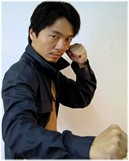 The independently-made feature film, Last Seen At Angkor is currently showing at theatres and festivals in the United States. It was shot on a shoestring budget, using mostly local actors, in Cambodia, Thailand and Laos. Written and directed by Michael R Morris, who also takes the lead role, it also co-starred Singaporean actor Wee Hong Thomas Lim (pictured). I asked Thomas for his recollections of Cambodia and the film:
The independently-made feature film, Last Seen At Angkor is currently showing at theatres and festivals in the United States. It was shot on a shoestring budget, using mostly local actors, in Cambodia, Thailand and Laos. Written and directed by Michael R Morris, who also takes the lead role, it also co-starred Singaporean actor Wee Hong Thomas Lim (pictured). I asked Thomas for his recollections of Cambodia and the film:
"Regarding Cambodia, shooting 'Angkor' was my second visit there. My first was in Jan 2002 which I enjoyed a lot more. That's not because the filming experience or Michael's company wasn't great but more so due to how fast Cambodia is changing. In 2002, there wasn't 'tuk-tuks' in Cambodia, just motor-bike taxis. Then they attached a carriage to the back and called it a tuk-tuk. I had a local friend in Cambodia in 2002, an elderly man whom me and Mike call 'Uncle Milo' and we had problems locating the travel agency that he owns not because he's moved but rather, the city/town changed too much in outlook. Phnom Penh too, the S21 Genocide Museum was so creepy the first time I visited but during that recent second visit, it did feel it became a lot more commercial. But still, if a friend comes to SE Asia, I'll still say he'll have to go to Cambodia for the great architecture and of course, come to Singapore! I feel sorry that Mike came all the way from LA and didn't really find time to properly visit the temples (we were more concerned about filming) but I believe he had a good time anyway.
I met Michael 4 or 5 years ago at the ShaoLin Temples in China. We're both kung fu enthusiasts (thats why we found ourselves there at Shaolin I guess) and as fate had it, we ended up travelling together, from the day we met, for almost 3 weeks, going through some good and bad experiences on the road together and had ourselves a good solid friendship before we parted in Beijing. And that same winter, I visited him and his family in Los Angeles. We kept in close touch ever since and decided to make 'Last Seen At Angkor' together. Regarding 'Last Seen At Angkor', I learnt so much from Michael shooting the film that I decided to put that knowledge to use by shooting my own short film called 'Kung-fu Doll' last summer in Tibet. This short film is also almost ready. Michael to me, is like a long distance big brother who always has valuable advice regarding not just films, but life in general too. In fact I'm putting up a solo theatre performance to tell of 3 amazing experiences/people I've had on my travels these past years and one of those experiences will be on my friendship with Michael.
Regarding myself, I'm from Singapore, residing in Beijing (China) since 3 years ago to train in Chinese Kung Fu. I'm an actor who's been doing theatre for 7 years and more recently, films. I just recently finished a Hallmark feature called 'Marco Polo' and will be backpacking through Mongolia for 2 weeks starting next week before heading south to Hong Kong to rehearse for my new theatre play which will be staged in October in Hong Kong. Then in December, I'll be staging the solo theatre performance in Macau (South China)."
You can read more about Thomas' work and travels here. And here's my original blog-post on Last Seen At Angkor.
New Khmer Architecture
 A non-profit organization with a different slant on looking at Phnom Penh is Khmer Architecture Tours, who promote and arrange tours of Post-Independence buildings in the Cambodian capital, such as those built by architect and urban planner Vann Molyvann. The modern architecture of Cambodia really took off in the late 1950s and 1960s with an explosion of what has been dubbed 'New Khmer Architecture,' integrating an international flavour alongside traditional form and materials in a unique style. KA Tours have even put out the first walking tour map of the capital's buildings, which you can download here for free. To see some of the architecture from the 1960s, click here. The photo is of the library building at Phnom Penh University (courtesy of John Caserta).
A non-profit organization with a different slant on looking at Phnom Penh is Khmer Architecture Tours, who promote and arrange tours of Post-Independence buildings in the Cambodian capital, such as those built by architect and urban planner Vann Molyvann. The modern architecture of Cambodia really took off in the late 1950s and 1960s with an explosion of what has been dubbed 'New Khmer Architecture,' integrating an international flavour alongside traditional form and materials in a unique style. KA Tours have even put out the first walking tour map of the capital's buildings, which you can download here for free. To see some of the architecture from the 1960s, click here. The photo is of the library building at Phnom Penh University (courtesy of John Caserta).
 his website to the hundreds of thousands of Khmer who found the camps haven and hell and to the thousands of expats who worked in the border camps over the years. A book that I have, called Beyond The Killing Fields with photos by Kari Rene Hall (pictured), tells the story in pictures and words of one of those camps, Site 2, at one time home to over 200,000 Cambodians and the largest concentration of Khmers outside the capital, Phnom Penh. If you can get hold of a copy of the book, its well worth having as Hall's black and white photos are superb.
his website to the hundreds of thousands of Khmer who found the camps haven and hell and to the thousands of expats who worked in the border camps over the years. A book that I have, called Beyond The Killing Fields with photos by Kari Rene Hall (pictured), tells the story in pictures and words of one of those camps, Site 2, at one time home to over 200,000 Cambodians and the largest concentration of Khmers outside the capital, Phnom Penh. If you can get hold of a copy of the book, its well worth having as Hall's black and white photos are superb. Friday, August 11, 2006
Yaz Alexander and Aisha
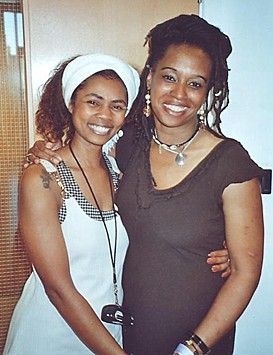 LtoR: Yaz Alexander and Aisha
LtoR: Yaz Alexander and AishaAnother photo that has only just been developed - this is no good, I must get into this digital photography lark - is this meeting of two fantastic reggae vocalists, Yaz Alexander and Aisha. Yaz is busting a gut in trying to break through as a solo artist after spending many years in the music business as a backing singer and vocal coach and is planning on getting her first solo album out sometime soon. You can keep up to date with Yaz at her website. Her collaborator at the Women-In-Music festival in Birmingham in early June was established roots reggae artist Aisha, who recently released her latest Ariwa CD, There Is More To Life. Aisha, who resides in Wolverhampton, teamed up with the Mad Professor in the late '80s to release Prophecy on his Ariwa Sounds label and to-date has released five solo albums. Read more about Aisha here.
Cathy Shipton - multi-talented actress
I keep telling myself to buy a digital camera and bring myself into the 21st century - but do I listen - obviously not! Instead I put my head in the sand and stick with my point and shoot and wait for the photo-lab to develop my photos - hence the delay. In this case, the photo below is of actress Cathy Shipton and yours truly outside the venue for the Schools for Children of Cambodia half-yearly meeting; during which Cathy told the audience of her recent experiences in Cambodia, where she was filming for the BBC tv series Casualty, and her visit to one of the schools that SCC are supporting by providing free education for the children who attend. The anniversary episode of Casualty - the reason why five of the cast members travelled to Cambodia - will be screened on the weekend of 23 & 24 September on BBC1 in the UK. Cathy tells me that her own daughter's school are planning to 'adopt' the Lolei school and will be sending them decorated boxes of pictures and gifts in the new year. Meanwhile, Cathy is starting a teaching course next month to add yet another string to her bow, that also includes authoring a book on running and completing no less than four marathons! You can read more about the SCC meeting here.
Wednesday, August 09, 2006
John Pilger - more than a messenger
 I knew nothing of the plight of Cambodia until I watched a documentary on 30 October 1979 that was to change my life. That documentary was produced by investigative journalist John Pilger and director David Munro for ATV and it was called Year Zero: The Silent Death of Cambodia. Coupled with his follow-up documentary a year later called Cambodia: Year One, it so aroused my interest in Cambodia that it led to an involvement with pressure groups and finally my first trip to the country in 1994. I've been back every year since. Fortunately, I've had the opportunity to tell the man himself of the impact his films have had on me. Its a tale he's heard many times after producing a shed-load of hard-hitting films and articles on topics such as Australia's Aborigines, Vietnam, Palestine, South Africa, Nicaragua, Burma and East Timor. However, it's been Pilger's expose of Cambodia in the following documentaries that have caught and held my attention:
I knew nothing of the plight of Cambodia until I watched a documentary on 30 October 1979 that was to change my life. That documentary was produced by investigative journalist John Pilger and director David Munro for ATV and it was called Year Zero: The Silent Death of Cambodia. Coupled with his follow-up documentary a year later called Cambodia: Year One, it so aroused my interest in Cambodia that it led to an involvement with pressure groups and finally my first trip to the country in 1994. I've been back every year since. Fortunately, I've had the opportunity to tell the man himself of the impact his films have had on me. Its a tale he's heard many times after producing a shed-load of hard-hitting films and articles on topics such as Australia's Aborigines, Vietnam, Palestine, South Africa, Nicaragua, Burma and East Timor. However, it's been Pilger's expose of Cambodia in the following documentaries that have caught and held my attention:
1979 Year Zero: The Silent Death of Cambodia
1980 Cambodia: Year One
1989 Cambodia: Year Ten
1990 Cambodia: The Betrayal
1993 Cambodia: Return to Year Zero
The DVD for his first Cambodia documentary, Year Zero is due to be released in mid-September and you can find out a lot more about Pilger and his work by logging onto this ITV website at www.johnpilger.com.
Tuesday, August 08, 2006
The Red Sense - a view from 'down under'
 A new film, called The Red Sense, by first-time Khmer-Australian director Tim Pek, deals with the Khmer Rouge Regime, and the upcoming trials, from the perspective of younger Khmers living in a western country. Actress Sarina Luy (pictured), plays the role of Kong Jan Melear, a thirty-something Khmer woman living in Australia, who discovers that her father’s killer is living freely in a first world country - an opportunity her father was never given. The film deals with her personal struggle as she tries to decide what the correct course of action is. Sarina Luy arrived in Australia in 1995 from New Zealand, after having left a refugee camp in Thailand in 1991.
A new film, called The Red Sense, by first-time Khmer-Australian director Tim Pek, deals with the Khmer Rouge Regime, and the upcoming trials, from the perspective of younger Khmers living in a western country. Actress Sarina Luy (pictured), plays the role of Kong Jan Melear, a thirty-something Khmer woman living in Australia, who discovers that her father’s killer is living freely in a first world country - an opportunity her father was never given. The film deals with her personal struggle as she tries to decide what the correct course of action is. Sarina Luy arrived in Australia in 1995 from New Zealand, after having left a refugee camp in Thailand in 1991.
Filmed in Australia, with real Khmer actors and actresses, Director Tim Pek elected to have 80% of the dialogue in Khmer (with English subtitles). His hope is that the film will motivate Cambodians to forget the past and to focus on the future. The film is scheduled for an independent release in Australia in November 2006, along with a public release in Phnom Penh. You can see the film trailer and photos here.
New Year Baby - work in progress
 Socheata Poeuv (pictured) was born on Cambodian New Year in a Thai refugee camp and her parents never told her how she got there. Then one Christmas Day, her parents called a family meeting. They sat her down with her brother and two older sisters to reveal astonishing secrets they'd kept locked away for 25 years. Her parent’s revelation raised more questions than it answered, so she became determined to document the full story - and New Year Baby is her personal documentary - a search for the truth about how her family survived the Khmer Rouge genocide and why they buried the truth for so long.
Socheata Poeuv (pictured) was born on Cambodian New Year in a Thai refugee camp and her parents never told her how she got there. Then one Christmas Day, her parents called a family meeting. They sat her down with her brother and two older sisters to reveal astonishing secrets they'd kept locked away for 25 years. Her parent’s revelation raised more questions than it answered, so she became determined to document the full story - and New Year Baby is her personal documentary - a search for the truth about how her family survived the Khmer Rouge genocide and why they buried the truth for so long.
Director and Producer Socheata Poeuv makes her filmmaking debut with New Year Baby. She is on the staff at NBC News Dateline in the US and made an emotional visit with her parents to Cambodia last year. The documentary is still in production and no date has yet been set for its release. However, you can find out more about the project at the New Year Baby website here.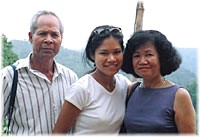
Socheata and her parents
Cambodia's Masterpieces
 Friends of Khmer Culture (FKC) is a non-profit organization that's been established to support Khmer arts and cultural organisations. Their first priority is to provide help to the National Museum of Cambodia in Phnom Penh. Anyone who has read my travelogues will know that the Museum is one of my favourite haunts when I'm in the capital and so the arrival of a brand new book by FKC is music to my ears. In a open-air launch at the Museum last week, KFC President Helen Jessup presented the new publication aimed at the growing numbers of foreign and local visitors to the Museum as well as a larger global readership. The book, titled Masterpieces of the National Museum of Cambodia, presents 80 masterpieces from the collection, in stone, wood and bronze, and is in four languages: Khmer, English, French, and Japanese. The publication is self-sustaining, with profits applied to projects proposed by the Museum that might include a bookshop, cafe and other much needed facilities including brochures and pamphlets for public education and to help with plans for improved display of the exhibits and training for the Museum's staff.
Friends of Khmer Culture (FKC) is a non-profit organization that's been established to support Khmer arts and cultural organisations. Their first priority is to provide help to the National Museum of Cambodia in Phnom Penh. Anyone who has read my travelogues will know that the Museum is one of my favourite haunts when I'm in the capital and so the arrival of a brand new book by FKC is music to my ears. In a open-air launch at the Museum last week, KFC President Helen Jessup presented the new publication aimed at the growing numbers of foreign and local visitors to the Museum as well as a larger global readership. The book, titled Masterpieces of the National Museum of Cambodia, presents 80 masterpieces from the collection, in stone, wood and bronze, and is in four languages: Khmer, English, French, and Japanese. The publication is self-sustaining, with profits applied to projects proposed by the Museum that might include a bookshop, cafe and other much needed facilities including brochures and pamphlets for public education and to help with plans for improved display of the exhibits and training for the Museum's staff.
You can find out more about Friends of Khmer Culture here.
Monday, August 07, 2006
Making a difference - SCC in Cambodia
 Yesterday I attended an informal gathering in London with the supporters and volunteers of the British-run charity, Schools for Children of Cambodia (SCC). This is a fledgling charity working to reverse the pattern of poverty in Cambodia through education. They literally fund free education programs by adopting existing schools and arrange for the teachers to be sponsored so that they don't need to charge the pupil's attendance fees, thus making education free. SCC also assist the more academically able children to attend fee-paying government secondary schools. They support five schools in the Siem Reap area and currently help 2,000 children, between the ages of 4-12 years old, attend school. In anyone's book that's a fantastic achievement for a charity formed by friends just three years ago. And with a bit of luck, and the support of actress Cathy Shipton, they may be able to do a lot more.
Yesterday I attended an informal gathering in London with the supporters and volunteers of the British-run charity, Schools for Children of Cambodia (SCC). This is a fledgling charity working to reverse the pattern of poverty in Cambodia through education. They literally fund free education programs by adopting existing schools and arrange for the teachers to be sponsored so that they don't need to charge the pupil's attendance fees, thus making education free. SCC also assist the more academically able children to attend fee-paying government secondary schools. They support five schools in the Siem Reap area and currently help 2,000 children, between the ages of 4-12 years old, attend school. In anyone's book that's a fantastic achievement for a charity formed by friends just three years ago. And with a bit of luck, and the support of actress Cathy Shipton, they may be able to do a lot more. Cathy, better-known to the tv viewing public as Nurse Duffy, filmed an anniversary episode of the popular BBC tv series Casualty in Cambodia recently - due to be screened on 23/24 September - and also spent an afternoon at SCC's Lolei school, some fifteen kilometres from Siem Reap, during her month-long stay in-country. "It was a wonderful, joyful occasion, I'll never forget it," was how Cathy (pictured) recalled her visit to yesterday's gathering. During her visit to Lolei school, she also took time out to film a piece for submission to the BBC's Lifeline Appeal and if its accepted by the broadcaster, it could really put SCC on the charity map. In the meantime, Georgina, Melissa, Glenn, Mark, Rachel and their supporters will continue their fund-raising efforts to give the children of Cambodia a free education. If you'd like to know more or can offer some support to SCC, go to their website at www.sccambodia.org.
Cathy, better-known to the tv viewing public as Nurse Duffy, filmed an anniversary episode of the popular BBC tv series Casualty in Cambodia recently - due to be screened on 23/24 September - and also spent an afternoon at SCC's Lolei school, some fifteen kilometres from Siem Reap, during her month-long stay in-country. "It was a wonderful, joyful occasion, I'll never forget it," was how Cathy (pictured) recalled her visit to yesterday's gathering. During her visit to Lolei school, she also took time out to film a piece for submission to the BBC's Lifeline Appeal and if its accepted by the broadcaster, it could really put SCC on the charity map. In the meantime, Georgina, Melissa, Glenn, Mark, Rachel and their supporters will continue their fund-raising efforts to give the children of Cambodia a free education. If you'd like to know more or can offer some support to SCC, go to their website at www.sccambodia.org.
Sunday, August 06, 2006
Ros Sereysothea - The Golden Voice
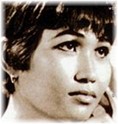 The guys at Jungle Bar have enlightened us to a forthcoming short film, The Golden Voice, by director Greg Cahill that focuses on the life of Cambodia's best-known female singing star of the 1960s and early 70s, Ros Sereysothea. As the interest in reviving Cambodian music from that golden period continues to gather pace, the film will be eagerly awaited by Cambodians inside and outside the country. Ros Sereysothea (pictured) lost her life under the Khmer Rouge regime. Visit the film's website here.
The guys at Jungle Bar have enlightened us to a forthcoming short film, The Golden Voice, by director Greg Cahill that focuses on the life of Cambodia's best-known female singing star of the 1960s and early 70s, Ros Sereysothea. As the interest in reviving Cambodian music from that golden period continues to gather pace, the film will be eagerly awaited by Cambodians inside and outside the country. Ros Sereysothea (pictured) lost her life under the Khmer Rouge regime. Visit the film's website here.
Saturday, August 05, 2006
On the road to Preah Vihear - 2002
 In March 2002, the distance between Tbeng Meanchey and Preah Vihear, the northernmost temple in Cambodia, on the track you see in this picture, took us six hours on my pal Sokhom's Daelim moto. Its a lot quicker these days after the track was converted into a road though back in 2002 we travelled through the forested area you see in the photo for two and a half hours and saw no sign of life except lizards scampering across our path, heard the constant shrill of cicadas and were reminded that the area was heavily mined by the HALO Trust warning signs posted every half kilometre - stepping off the track was not an option. Though the 'romance' (who am I kidding!) of the old road is now gone forever, you can still take a similar trip on many back-roads throughout Cambodia. In January, Sokhom and I, and the trusty Daelim, took the track between the northern outposts of Choam Khsan and Tbeng Meanchey and it was just like stepping back to March 2002. Excuse the pose, my lower back was killing me and I was attempting to stand up as straight as I could whilst we took a quick break.
In March 2002, the distance between Tbeng Meanchey and Preah Vihear, the northernmost temple in Cambodia, on the track you see in this picture, took us six hours on my pal Sokhom's Daelim moto. Its a lot quicker these days after the track was converted into a road though back in 2002 we travelled through the forested area you see in the photo for two and a half hours and saw no sign of life except lizards scampering across our path, heard the constant shrill of cicadas and were reminded that the area was heavily mined by the HALO Trust warning signs posted every half kilometre - stepping off the track was not an option. Though the 'romance' (who am I kidding!) of the old road is now gone forever, you can still take a similar trip on many back-roads throughout Cambodia. In January, Sokhom and I, and the trusty Daelim, took the track between the northern outposts of Choam Khsan and Tbeng Meanchey and it was just like stepping back to March 2002. Excuse the pose, my lower back was killing me and I was attempting to stand up as straight as I could whilst we took a quick break.
Friday, August 04, 2006
A French look at Cambodia
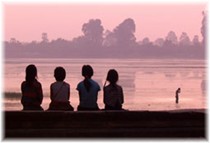 A riverside scene from Dogora
A riverside scene from Dogora 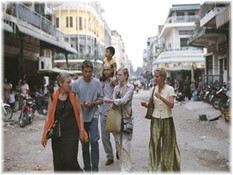
A street scene from Holy Lola
Inspiring stories - Ken Finn
 I've just received an e-mail from Paul Goodwin, author of Planetary Voices Radio, an audio website featuring environmental issues, human rights, peace work and life affirming interviews from people passionate about their causes. It features over 80 such interviews including one with Ken Finn, the author of the 2005 book, My Journey with a Remarkable Tree, which describes Finn's travels to find the spirit trees of Cambodia and which takes him further into the problems facing the country's disappearing forests. You can read more about Finn's book and his causes at www.ken-finn.com. In addition to the interview with Finn (pictured), there's a short interview with Mike Davis of Global Witness, who talks about the challenges and successes of his organisation's work in Cambodia. Global Witness have a reputation for ruffling the feathers of the political leadership in Cambodia and you can read about their work here.
I've just received an e-mail from Paul Goodwin, author of Planetary Voices Radio, an audio website featuring environmental issues, human rights, peace work and life affirming interviews from people passionate about their causes. It features over 80 such interviews including one with Ken Finn, the author of the 2005 book, My Journey with a Remarkable Tree, which describes Finn's travels to find the spirit trees of Cambodia and which takes him further into the problems facing the country's disappearing forests. You can read more about Finn's book and his causes at www.ken-finn.com. In addition to the interview with Finn (pictured), there's a short interview with Mike Davis of Global Witness, who talks about the challenges and successes of his organisation's work in Cambodia. Global Witness have a reputation for ruffling the feathers of the political leadership in Cambodia and you can read about their work here.
Sunrise Children's Village
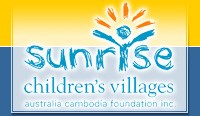 I urge you to read about the Sunrise Children's Village here. The folks who run the orphanage, like Geraldine Cox, Gerald Trevor and Rosanna White have been regular e-pals for quite a few years and I've been fortunate to visit their wonderful children's home on a couple of occasions. My last visit in January 2003 was to their new purpose-built location in Takhmau and I was fortunate to witness dance practice and to have lunch with the younger children. One of the dancers was Sok Heng and the picture below brings the memories of that visit flooding back. Geraldine Cox, the larger than life founder of the orphanage, has published a moving account of her life in Home Is Where the Heart Is, and I recommend you get hold of a copy of her book. You can read more about Geraldine and the orphanage here.
I urge you to read about the Sunrise Children's Village here. The folks who run the orphanage, like Geraldine Cox, Gerald Trevor and Rosanna White have been regular e-pals for quite a few years and I've been fortunate to visit their wonderful children's home on a couple of occasions. My last visit in January 2003 was to their new purpose-built location in Takhmau and I was fortunate to witness dance practice and to have lunch with the younger children. One of the dancers was Sok Heng and the picture below brings the memories of that visit flooding back. Geraldine Cox, the larger than life founder of the orphanage, has published a moving account of her life in Home Is Where the Heart Is, and I recommend you get hold of a copy of her book. You can read more about Geraldine and the orphanage here.
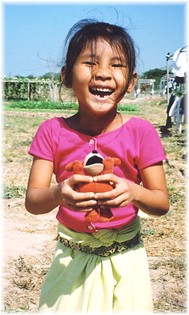
Favourite photos...3
These happy, smiling youngsters were part of a large group I met in the grounds of Wat Stung Meanchey, on the outskirts of Phnom Penh in March 1998. Accompanied by Onphum, my moto-driver, we were returning from a visit to Choeung Ek, when we pulled into the grounds of Wat Stung Meanchey, boasting a large collection of statues, murals and paintings in bright colours. Also in the grounds of the pagoda was a large group of children. Always eager to make a fool of myself, I joined in their game of 'kop sbek cheung', the Khmer name for flip-flop throwing and found my aim left a lot to be desired, much to their delight and amusement. The photo above was taken just as I was leaving, as they sent me on my way with handshakes, waves and smiling faces.
Accompanied by Onphum, my moto-driver, we were returning from a visit to Choeung Ek, when we pulled into the grounds of Wat Stung Meanchey, boasting a large collection of statues, murals and paintings in bright colours. Also in the grounds of the pagoda was a large group of children. Always eager to make a fool of myself, I joined in their game of 'kop sbek cheung', the Khmer name for flip-flop throwing and found my aim left a lot to be desired, much to their delight and amusement. The photo above was taken just as I was leaving, as they sent me on my way with handshakes, waves and smiling faces.
Monsoon Wife - part 2
 In an effort to clarify the story behind Monsoon Wife, I fired off an email to Director Marlin Darrah and he replied immediately with some more background information.
In an effort to clarify the story behind Monsoon Wife, I fired off an email to Director Marlin Darrah and he replied immediately with some more background information.
Butterfly Man was the movie's original title but he decided to scrap that name when he learnt of another movie being made by a British-Thai outfit in the same year and in SEAsia, with a similar theme. Monsoon Wife is the official name of his movie. 93 minutes in length and as described on the website www.monsoonwife.com. The film was bought for a small sum of money by Universal Pictures and its subsidiary for distribution across the US in DVD form. Unfortunately, those marketing the movie took the liberty to change the name to Monsoon Wife - Return to the Kama Sutra, in an attempt to spice up the title without even getting permission from Darrah himself. He points out; "Monsoon Wife is not an erotic film as they would probably like to suggest. They even put Indian women on the DVD cover rather than Cambodians! Such are the horror stories of agents and distributors ..."
And the third title, Stealing Cambodia, is still the same movie, but shortened to 83 minutes in an attempt to recut the film for acceptance at the Sundance Film Festival. It wasn't accepted but nevertheless, has received a stack of favourable critical reviews and been a finalist or winner at 15 international film festivals to date. Not bad for a small-budget, first-time independent hybrid movie composed primarily of fictional feature film elements mixed with documentary elements by Director Darrah. "My film is first and foremost a drama, a love story set in an exotic land. It’s a movie and it’s entertainment. But it also educates. Many distributors don’t know how to handle the ‘social issue’ aspect of the movie," he said. "We wanted to make people feel very repelled by the child prostitution issue, but we took a gamble, realizing that they might also be repelled by the movie as a whole. There are a couple of very hard, very true-to-life scenes the audience must get through. They’re tough to watch for some viewers..."
Thursday, August 03, 2006
Monsoon Wife
 Another film that you may get an opportunity to see is Monsoon Wife, directed by Marlin Darrah and filmed entirely on location in Cambodia in 2001. It's been around a while and has been shown at numerous film festivals around the world, winning a few best film awards at the same time. A 92-minute feature film, shot on a tight budget of just $95,000, and Darrah's first after a career of documentary film-making, its a controversial story immersed in the world of sexual obsession and prostitution, with a percentage of revenue from the film finding its way to two NGO's devoted to ending child prostitution in SEAsia including the CWCC in Phnom Penh. The main character's love interest is Teeda, played by American actress Linda Shing. Just before filming began, Linda (pictured) was in touch by email seeking a flavour of what to expect in a part of SEAsia that she'd never been to before and following her part in this film, she's gone onto earn a regular role in the American hospital drama ER, a lead role in the ABC series Commander In Chief and other film roles. I've not seen Monsoon Wife myself, though I believe its available on DVD, so if anyone wants to send me a copy....
Another film that you may get an opportunity to see is Monsoon Wife, directed by Marlin Darrah and filmed entirely on location in Cambodia in 2001. It's been around a while and has been shown at numerous film festivals around the world, winning a few best film awards at the same time. A 92-minute feature film, shot on a tight budget of just $95,000, and Darrah's first after a career of documentary film-making, its a controversial story immersed in the world of sexual obsession and prostitution, with a percentage of revenue from the film finding its way to two NGO's devoted to ending child prostitution in SEAsia including the CWCC in Phnom Penh. The main character's love interest is Teeda, played by American actress Linda Shing. Just before filming began, Linda (pictured) was in touch by email seeking a flavour of what to expect in a part of SEAsia that she'd never been to before and following her part in this film, she's gone onto earn a regular role in the American hospital drama ER, a lead role in the ABC series Commander In Chief and other film roles. I've not seen Monsoon Wife myself, though I believe its available on DVD, so if anyone wants to send me a copy....
You can read more about the film here. I've also seen the film listed under the titles of Butterfly Man and Stealing Cambodia, though Monsoon Wife appears to be the main distribution title.
Wednesday, August 02, 2006
Koreans top the chart but fewer Brits
 The number of foreign visitors to Cambodia has increased in the first six months of 2006. From January to June, 813,392 tourists and those on business visited Cambodia, 19% more than the same period of 2005, according to the Ministry of Tourism. South Korean tourists are still at the top of the list numbering 148,000, followed by Japan at 70,000 and United States with 60,000, while the numbers of tourists from the UK and France decreased. In fact, my trip in January meant I was one of 34,000 UK visitors in the first six months of this year. Minister of Tourism Lay Prohas (pictured) said the ministry is confident that it can reach its target of 1.6 million visitors for 2006, which should generate 1.2 billion US dollars in revenue. Tourism is one of the main sources of foreign exchange revenue for the country.
The number of foreign visitors to Cambodia has increased in the first six months of 2006. From January to June, 813,392 tourists and those on business visited Cambodia, 19% more than the same period of 2005, according to the Ministry of Tourism. South Korean tourists are still at the top of the list numbering 148,000, followed by Japan at 70,000 and United States with 60,000, while the numbers of tourists from the UK and France decreased. In fact, my trip in January meant I was one of 34,000 UK visitors in the first six months of this year. Minister of Tourism Lay Prohas (pictured) said the ministry is confident that it can reach its target of 1.6 million visitors for 2006, which should generate 1.2 billion US dollars in revenue. Tourism is one of the main sources of foreign exchange revenue for the country.
In 1999, Cambodia welcomed 367,743 tourists, though with 1,421,000 visitors in 2005, tourist arrivals have increased by 286% and earned about 10 million US dollars. The Ministry of Tourism estimated that the average tourist spent approximately $770 while visiting the country. They predict that the tourism sector will continue to grow by 25-30% until 2010. Way back in 1994 when I visited Cambodia for the very first time, tourist arrivals totalled just 133,341 for the whole year, with a meagre 5,000 from the UK. As Welsh singer Mary Hopkin would say; "Those were the days my friend..."
Tuesday, August 01, 2006
Salute to Steve Coogan
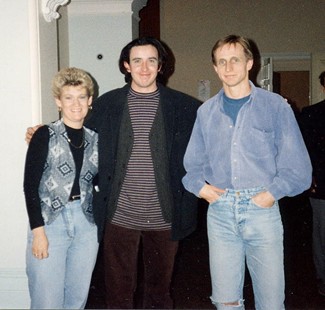 In my younger days I used to watch live alternative comedy as if my life depended on it. Because I never missed a show at the Cheltenham Town Hall - Pillar Room, I saw the cream of the crop including Frank Skinner, Ben Elton, Lee Evans, Jo Brand, Paul Merton, everyone who was anyone and most of them just before they became the big names they are today. However, one man who could throw his voice and mimic anyone, and who was a superb stand-up comic was the legendary Steve Coogan. Known to most British tv viewers as Alan Partridge, the former radio dj and tv presenter who made us cringe throughout each of his programmes, Coogan's latest tv series, Saxondale, ends tonight. There's lots more to Coogan's armoury including his continuing flirtation with film-stardom and you can read all about it here. In the photo above, taken in 1995, my wife and I caught up with Steve for a chat after he'd just finished a stand-up show at the Town Hall. Great comic, and nice guy to boot.
In my younger days I used to watch live alternative comedy as if my life depended on it. Because I never missed a show at the Cheltenham Town Hall - Pillar Room, I saw the cream of the crop including Frank Skinner, Ben Elton, Lee Evans, Jo Brand, Paul Merton, everyone who was anyone and most of them just before they became the big names they are today. However, one man who could throw his voice and mimic anyone, and who was a superb stand-up comic was the legendary Steve Coogan. Known to most British tv viewers as Alan Partridge, the former radio dj and tv presenter who made us cringe throughout each of his programmes, Coogan's latest tv series, Saxondale, ends tonight. There's lots more to Coogan's armoury including his continuing flirtation with film-stardom and you can read all about it here. In the photo above, taken in 1995, my wife and I caught up with Steve for a chat after he'd just finished a stand-up show at the Town Hall. Great comic, and nice guy to boot.
Tim Clark hosted the first 'Pillar Talk' show way back in January 1990 and over the next decade many of the UK's finest comedians did their turn including another fave of mine, Jeff Green. Read all about Jeff here.

